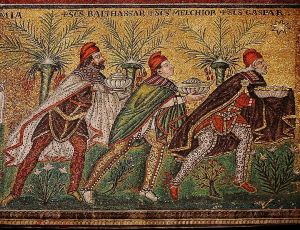Opening Voluntary: Prelude on “We three kings of orient are” – Carlos Staszeski (b. 1935)
Today’s opening voluntary is based on the American Christmas / Epiphany carol, “We three kings of orient are” found in our Hymnal 1982 as # 128. Both text and tune of this carol are the work of John Henry Hopkins, Jr. (1820-1891). Hopkins was born in Pittsburg, PA in 1820 as the son of the Right Reverend John Henry Hopkins, an Episcopal bishop. He was initially educated at the University of Vermont, where he took both a bachelor’s and master’s degree. He worked for a time as a journalist and then entered and was graduated from General Theological Seminary, the oldest seminary in the Episcopal Church, in the year 1850. He served as the seminary’s first teacher of music in the years 1855-1857, and it was during this period that he wrote and composed the carol, “We three kings of orient are,” for a Christmas pageant for his nieces and nephews. It was not published until six years later in 1863 in his work, Carols, Hymns and Songs. Hopkins subsequently served as rector of Christ Episcopal Church in Williamsport, PA. He died in Hudson, York and was buried next to his father at Bishop’s House, Rock Point, Burlington, Vermont.
The text of “We three kings” recounts the Epiphany story from the Gospel of Matthew of the coming of the Magi. There is, of course, no mention in the Gospel as to the actual number of the Magi, but from the three-fold gifts that they presented to the Christ child, they have been traditionally pictured as having been three. This numeration in Western Christianity dates at least as early as the time of the church father, Origen (185-254), although in the Syrian Church there are traditions that suggest that there were was many as twelve. By the Middle ages, the “three” Magi had even acquired names, and their place in popular piety was enlarged by episodes in mystery plays and a whole genre of what are known as “three kings plays.” Their supposed relics were transferred in 1162 by Frederick Barbarossa from Milan to Cologne Cathedral where they are enshrined to this day in a magnificent silver and bronze gilded and jewel-covered reliquary created by Nicholas of Verdun in 1190. The shrine was opened in 1864 and found to contain bones and clothing.
The opening voluntary, presenting several variations in harmony and registration on the carol tune, is the work of Carlos Staszeski, born 1935 in Buenos Aires, Argentina. He studied in New York City at the Guilmant Organ School and the Manhattan School of Music. He currently serves as organist and director of music at St. Stephen’s Episcopal Church in Waretown, New Jersey.


Leave a comment